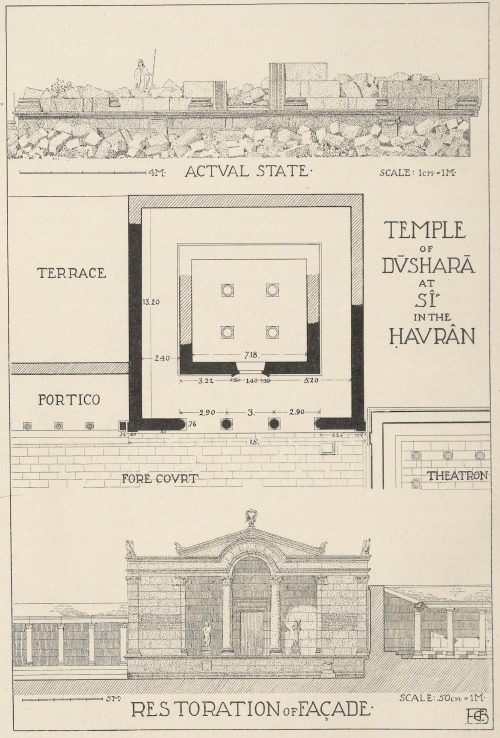classicalmonuments:Temple of DusharaSi (Seeia), Hauran, Syria1st century BCEThe ground-plan was unmi
classicalmonuments:Temple of DusharaSi (Seeia), Hauran, Syria1st century BCEThe ground-plan was unmistakably of the same type as that of the temple of Ba'al Shamin, although it is not similar in all details, and is on a somewhat smaller scale, its façade being a little over 15 m. wide as opposed to 19 m. in the other temple. But here we have again the outer wall and the interior cella with a passage between them. Again we have the distyle entrance, but not the recessed porch of the temple of Ba'al Shamin. Here the two columns stand between half-columns at the ends of walls that extend from the angles of the building to the line of the interior cella, and the passage behind the columns is continuous with the passage around the cella. The cella has but one doorway; its front wall and parts of its two side walls are in situ. The location of the rear portion of the outer wall of the temple was determined from foundations well down the slope; the outer walls formed a square. The rear wall of the inner cella could not be found. The passage between the columns and the cella wall is 2.76 m. wide, the passage on the right is 2 m. wide, that on the left 2.40 m. If the inner cella was square the passage in the rear would have been only i.6o m. wide. In the plan I have drawn a conjectured wall which makes the cella slightly oblong. The four interior columns are placed on conjecture from broken shafts lying on the slope behind the temple.The ornament of this temple, though not exactly similar to that of the temple of Ba’al Shamin, is entirely in keeping with it (Ill. 336). The mouldings of the podium-cap, the architrave, and the cornice, are no more than alternating series of ovolos and cavettos which are not segmental. The torus mouldings of the column- bases have a profile which is characteristic of Nabataean work, being not semicircular but much flattened. The capitals (Ill. 337) have but a single row of large leaves of the thick, heavy, acanthus type, the volutes are also thick, and the abacus very heavy and moulded with two sunken cavettos. The most interesting features of these capitals are the grotesque human figures which appear in the middle of the outer faces of the two capitals and the faces of the half capitals which are turned toward the middle inter- columniation. These grotesques represent the heads, shoulders, and arms of figures a little below half natural size. The heads are bald, the faces grinning, and the hands clasp the tops of the mid-leaves of the capitals.The astragal below each capital is treated with rope ornament. The carved ornament of the doorway of the cella is more like that of the entrance to the theatron than that of the doorways of the great temple which are decorated with grape-vine. This may indicate that the temple of Dushara belongs rather to the end of the period from 33 to 13 b. c. than to the time of the temple of Bacal Shamin. There can be no doubt that this temple belongs to the period mentioned in theinscription 1 upon the architrave of the peristyle of the theatron.Among the fragments of sculpture found within the doorway of the temple was the lower part of the drapery and the feet of a statue, a little larger than life-size (Ill. 337). The feet are represented as treading out wine from grapes; the wine is depicted by wavy lines flowing from the crushed fruit, and a face, probably personifying the wine, is shown protruding from the grapes. The face was broken off, but was found, and is shown in Ill. 334, Frag. P. The statue to which this fragment belonged could have been no other than that of Dushara, the wine-god of the Nabataeans, and it was the presence of this statue in the temple, as well as the importance of this divinity, which was only second to that of Ba’alShamin, that suggested to us that the newly-found temple was dedicated to Dushara.Sources: 1 ,2 ,3 (colorized using playback) -- source link
Tumblr Blog : classicalmonuments.tumblr.com








